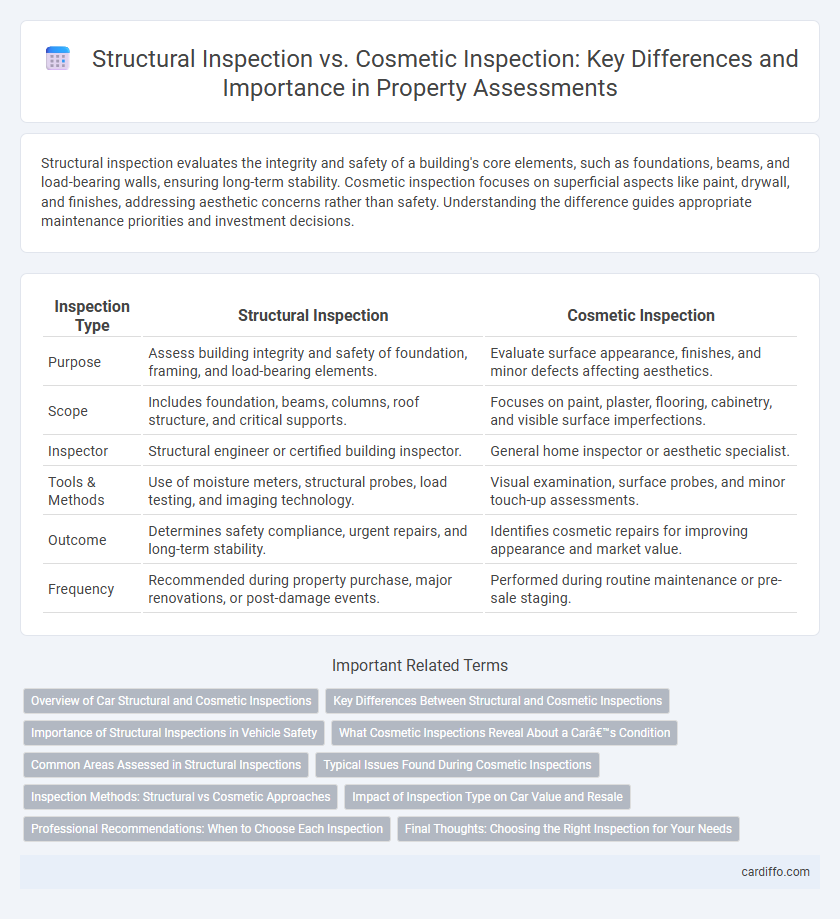Structural inspection evaluates the integrity and safety of a building's core elements, such as foundations, beams, and load-bearing walls, ensuring long-term stability. Cosmetic inspection focuses on superficial aspects like paint, drywall, and finishes, addressing aesthetic concerns rather than safety. Understanding the difference guides appropriate maintenance priorities and investment decisions.
Table of Comparison
| Inspection Type | Structural Inspection | Cosmetic Inspection |
|---|---|---|
| Purpose | Assess building integrity and safety of foundation, framing, and load-bearing elements. | Evaluate surface appearance, finishes, and minor defects affecting aesthetics. |
| Scope | Includes foundation, beams, columns, roof structure, and critical supports. | Focuses on paint, plaster, flooring, cabinetry, and visible surface imperfections. |
| Inspector | Structural engineer or certified building inspector. | General home inspector or aesthetic specialist. |
| Tools & Methods | Use of moisture meters, structural probes, load testing, and imaging technology. | Visual examination, surface probes, and minor touch-up assessments. |
| Outcome | Determines safety compliance, urgent repairs, and long-term stability. | Identifies cosmetic repairs for improving appearance and market value. |
| Frequency | Recommended during property purchase, major renovations, or post-damage events. | Performed during routine maintenance or pre-sale staging. |
Overview of Car Structural and Cosmetic Inspections
Car structural inspections evaluate the integrity of key components such as the frame, chassis, and suspension to identify damage from accidents or corrosion that could compromise safety and performance. Cosmetic inspections focus on surface-level issues like paint condition, dents, scratches, and minor panel misalignments that affect the vehicle's aesthetic appearance but not its functionality. Both inspections are crucial for assessing a vehicle's overall condition, with structural inspections prioritizing safety and mechanical soundness, while cosmetic inspections address visual appeal and market value.
Key Differences Between Structural and Cosmetic Inspections
Structural inspections evaluate the integrity and safety of a building's load-bearing components, including foundations, beams, and columns, ensuring compliance with engineering standards and identifying potential hazards. Cosmetic inspections focus on surface-level issues such as paint, drywall, and finishes, primarily addressing aesthetic defects rather than safety concerns. The key difference lies in structural inspections targeting functional durability and code compliance, while cosmetic inspections assess visual appeal and minor wear.
Importance of Structural Inspections in Vehicle Safety
Structural inspection is crucial in vehicle safety as it evaluates the integrity of key components like the frame, chassis, and suspension system, which directly affect crashworthiness and overall stability. Unlike cosmetic inspections that focus on surface appearance and minor damages, structural inspections detect hidden defects such as cracks, corrosion, or misalignments that can compromise safety. Regular structural inspections help prevent accidents by ensuring the vehicle's core framework meets safety standards and functions properly during collisions.
What Cosmetic Inspections Reveal About a Car’s Condition
Cosmetic inspections reveal visible surface issues such as paint damage, minor dents, and interior wear that indicate how well a car has been maintained and cared for. These inspections help identify cosmetic flaws that do not typically affect the vehicle's functionality but can influence its resale value and aesthetic appeal. Unlike structural inspections, cosmetic evaluations do not uncover underlying mechanical or safety-related problems.
Common Areas Assessed in Structural Inspections
Structural inspections commonly assess foundational elements such as load-bearing walls, beams, columns, and support systems to ensure safety and integrity. Inspectors examine the condition of the roof structure, concrete slabs, and the framing for signs of damage or deterioration. Unlike cosmetic inspections, which focus on surface appearance, structural inspections prioritize underlying components critical to the building's stability and functionality.
Typical Issues Found During Cosmetic Inspections
Typical issues found during cosmetic inspections include paint chipping, surface stains, minor cracks, and fading materials, which primarily affect visual appeal rather than structural integrity. These inspections identify wear and tear such as scratches, discoloration, and small dents that do not impact the safety or functionality of a building. Unlike structural inspections, cosmetic inspections focus on maintaining aesthetic standards and preventing superficial deterioration.
Inspection Methods: Structural vs Cosmetic Approaches
Structural inspection methods prioritize evaluating the integrity and safety of load-bearing elements through techniques like ultrasonic testing, radiographic imaging, and strain gauge monitoring. Cosmetic inspection approaches focus on surface-level assessments using visual examination, color analysis, and texture mapping to identify aesthetic defects such as cracks, discoloration, and surface wear. Employing the appropriate inspection method ensures accurate detection of critical structural issues or superficial cosmetic flaws, optimizing maintenance and repair strategies.
Impact of Inspection Type on Car Value and Resale
Structural inspections identify critical issues affecting a vehicle's safety and long-term durability, directly influencing car value and resale potential by detecting hidden damages that reduce market worth. Cosmetic inspections focus on surface-level imperfections such as paint, dents, and interior wear, impacting aesthetic appeal but generally causing less depreciation. Buyers prioritize structural condition over cosmetic flaws, making thorough structural inspections a key factor in preserving vehicle value during resale.
Professional Recommendations: When to Choose Each Inspection
Professional recommendations emphasize choosing structural inspections when assessing a building's integrity, focusing on load-bearing elements, foundations, and potential safety hazards. Cosmetic inspections are suitable for evaluating surface-level issues such as paint, finishes, and minor damages that do not compromise structural stability. Homeowners and buyers prioritize structural inspections during property transactions, renovations, or after events like earthquakes, while cosmetic inspections are ideal for routine maintenance and aesthetic evaluations.
Final Thoughts: Choosing the Right Inspection for Your Needs
Structural inspections assess the integrity of foundational elements such as beams, load-bearing walls, and roofing systems, ensuring safety and compliance with building codes. Cosmetic inspections focus on surface-level issues like paint, fixtures, and minor repairs, prioritizing aesthetic appeal rather than structural soundness. Selecting the right inspection depends on whether the priority is long-term durability or visual condition, with structural inspections being critical for property safety and cosmetic inspections suitable for appearance-focused evaluations.
Structural inspection vs cosmetic inspection Infographic

 cardiffo.com
cardiffo.com